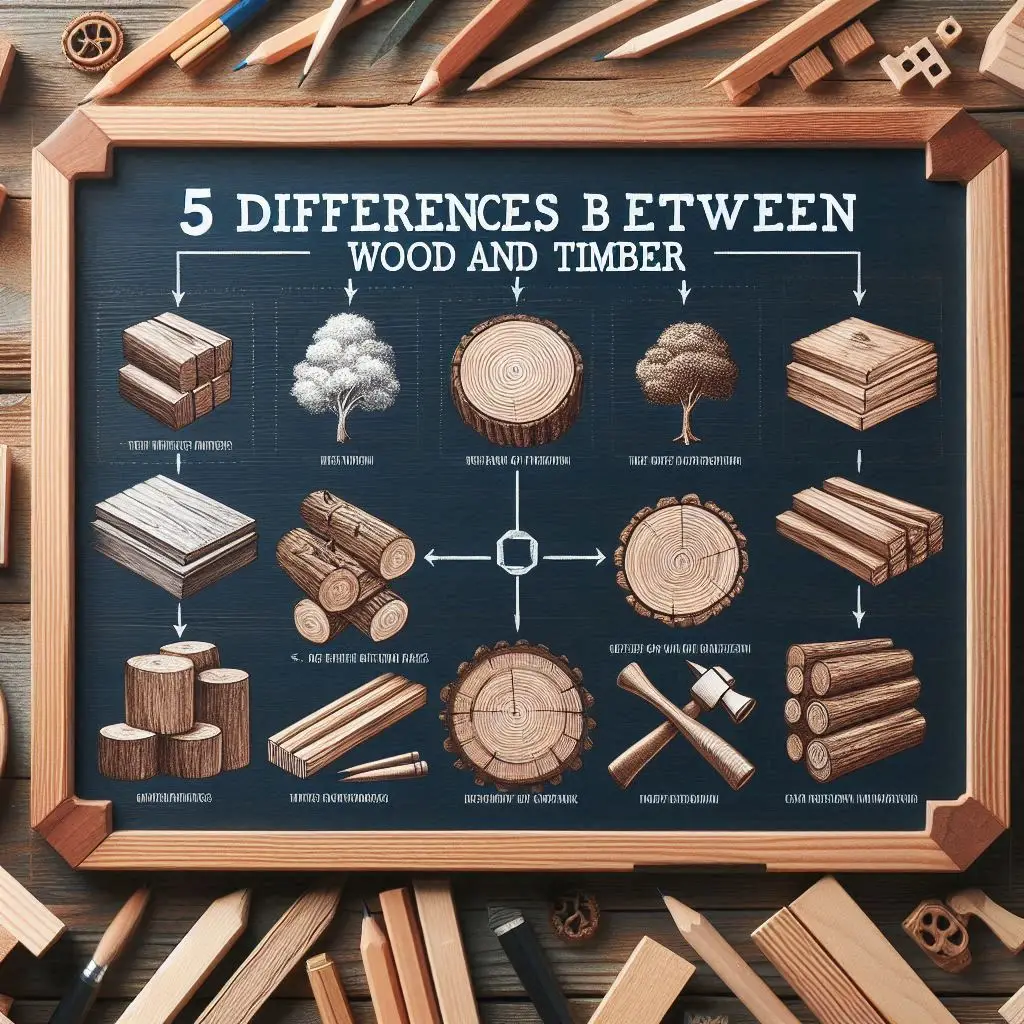
5 Differences Between Wood and Timber
Introduction
This article will explore five (5) key differences between wood and timber, shedding light on their unique characteristics and applications.
Wood and timber are terms that are often used interchangeably, but they carry distinct meanings depending on context and usage. Understanding the differences between wood and timber is crucial for professionals in industries such as construction, furniture making, and even agriculture. While both materials originate from trees, their processing, purposes, and definitions vary significantly.
Difference 1: Definition and Terminology
The first major difference between wood and timber lies in their definitions. Wood refers to the organic material derived from trees and shrubs, consisting of cellulose fibers embedded in a matrix of lignin, which provides strength and rigidity. It is the primary raw material found in the trunk and branches of trees and is used in a variety of ways, from fuel to building materials.
Timber, on the other hand, is a term often used to describe wood that has been processed and is ready for use in construction or carpentry. In some regions, timber refers to trees that have been cut down but not yet processed, while in others, it specifically denotes sawn wood used for building. Essentially, all timber is wood, but not all wood qualifies as timber. This distinction is particularly important in industries where precise terminology can affect the quality and outcome of a project.
Difference 2: Processing and Preparation
Wood and timber differ significantly in terms of processing and preparation. Wood, in its raw form, is typically harvested directly from trees and may undergo minimal processing before being used. Raw wood can be used for firewood, small craft projects, or as a raw material for further processing into various wood products.
Timber, however, undergoes a more extensive preparation process. After trees are felled, the wood is cut, seasoned, and often treated to enhance its durability and resistance to pests and decay. Timber is usually sawn into specific sizes and shapes suitable for construction, such as beams, planks, and posts. The preparation of timber ensures it meets the standards required for structural integrity in buildings and other projects. This additional processing sets timber apart from wood in terms of its suitability for various applications.
Difference 3: Usage and Applications
The third difference is found in the usage and applications of wood and timber. Wood, in its unprocessed or minimally processed state, is versatile and can be used for various purposes. It is often used as a source of fuel, in the production of paper, and in crafting everyday items such as furniture, tools, and decorations. Wood's applications are diverse and range from basic to highly intricate uses.
Timber, however, is primarily used in construction and large-scale carpentry projects. Due to its strength and stability, timber is the preferred material for building structures, including homes, bridges, and commercial buildings. Its reliability and uniformity make it ideal for use in projects where safety and longevity are critical. Timber’s applications are more specialized than those of wood, making it an essential material in the construction industry.
Difference 4: Durability and Treatment
Durability and treatment are crucial factors that differentiate wood from timber. While raw wood can be susceptible to rot, insect infestation, and environmental damage, timber is often treated to increase its longevity and resilience. The treatment process may involve chemical preservatives, pressure treatment, or kiln drying to remove moisture and prevent decay.
Timber's enhanced durability makes it suitable for outdoor and structural use, where exposure to the elements is a concern. Treated timber can last for decades, even in harsh conditions, making it a reliable choice for construction projects. In contrast, untreated wood is more appropriate for indoor use or in situations where longevity is not a primary concern.
The difference in treatment between wood and timber is a key factor in their respective durability, further distinguishing them in terms of practicality and value.
Difference 5: Economic and Environmental Impact
The economic and environmental impacts of wood and timber also set them apart. Wood, as a raw material, is often less expensive and more readily available than timber. Its use in various industries, including agriculture, construction, and manufacturing, supports numerous economies worldwide. However, the overharvesting of wood can lead to deforestation and environmental degradation if not managed sustainably.
Timber, due to its processing requirements, is generally more costly but offers greater economic value in the long term, especially in the construction industry. The use of timber supports sustainable forestry practices when sourced from well-managed forests. Furthermore, timber production often involves the use of waste wood and byproducts, contributing to a more efficient use of natural resources.
The environmental impact of wood versus timber is also influenced by their respective lifespans and applications. Timber, with its extended durability and specific uses, often results in a lower environmental footprint over time compared to raw wood, particularly when used in long-lasting structures.
Conclusion
In conclusion, while wood and timber share a common origin in trees, they differ significantly in definition, processing, usage, durability, and economic impact. Wood, in its raw form, is versatile and widely used across various industries, but it lacks the specialized treatment and preparation that timber undergoes. Timber, with its enhanced durability and suitability for construction, plays a critical role in the building industry and contributes to sustainable practices when sourced responsibly. Understanding these differences is essential for making informed decisions in projects that involve either material. Whether choosing wood for its natural simplicity or timber for its structural reliability, the right choice depends on the specific requirements and goals of the task at hand.

